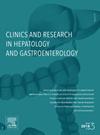Clinical use of per ERCP bile aspiration in patients with cholangitis: The aspibile study
IF 2.4
4区 医学
Q2 GASTROENTEROLOGY & HEPATOLOGY
Clinics and research in hepatology and gastroenterology
Pub Date : 2025-04-22
DOI:10.1016/j.clinre.2025.102599
引用次数: 0
Abstract
Background and study aims
Bile aspiration during endoscopic retrograde cholangiopancreatography (ERCP) for cholangitis is not systematic and data on its clinical relevance remain limited. The aim of this study was to evaluate the clinical contribution of biliary aspiration in the setting of cholangitis.
Methods
Consecutive patients with ERCP performed for cholangitis were included. The primary outcome was the rate of adaptation of antibiotic therapy to biliary aspirations. Secondary outcomes were length of hospitalization, mortality, cholangitis recurrence at 30 days, duration of antibiotic therapy, antibiotic change, agreement between antibiotic therapy and biliary aspiration.
Results
A total of 140 patients were included, 103 (73.6 %) had blood cultures before ERCP. The rate of empiric and adjusted antibiotics effectively targeting bacteria found in bile was 82.1 % and 85.4 %, respectively. The mean length of hospital stay was 15.7 days, cholangitis recurrence rate was 3.2 % and the mortality rate was 5.5 %. The mean duration of antibiotic therapy was 11.3 days with an antibiotic modification rate of 45 %.
Conclusions
Bile aspiration during ERCP for acute cholangitis is a valuable complement to blood culture providing a higher diagnostic yield and enabling targeted antibiotic therapy. The rate of antibiotics effectively targeting bacteria found in bile is higher than 80 %.
胆管炎患者应用per ERCP抽吸胆汁的临床应用:胆汁研究
背景和研究目的内镜逆行胆管胰胆管造影(ERCP)治疗胆管炎时吸胆尚无系统性研究,其临床相关性数据仍然有限。本研究的目的是评价胆道穿刺治疗胆管炎的临床价值。方法纳入连续行ERCP治疗胆管炎的患者。主要结果是抗生素治疗对胆道渴望的适应率。次要结局是住院时间、死亡率、30天胆管炎复发、抗生素治疗持续时间、抗生素变化、抗生素治疗与胆道抽吸的一致性。结果共纳入140例患者,其中103例(73.6%)在ERCP术前进行了血培养。经验抗生素和调整抗生素有效靶向胆汁细菌的比例分别为82.1%和85.4%。平均住院时间15.7 d,胆管炎复发率3.2%,死亡率5.5%。抗生素治疗的平均持续时间为11.3天,抗生素改良率为45%。结论急性胆管炎ERCP期间的胆汁抽吸是对血培养的一种有价值的补充,可提供更高的诊断率和靶向抗生素治疗。抗生素有效靶向胆汁中细菌的比率高于80%。
本文章由计算机程序翻译,如有差异,请以英文原文为准。
求助全文
约1分钟内获得全文
求助全文
来源期刊

Clinics and research in hepatology and gastroenterology
GASTROENTEROLOGY & HEPATOLOGY-
CiteScore
4.30
自引率
3.70%
发文量
198
审稿时长
42 days
期刊介绍:
Clinics and Research in Hepatology and Gastroenterology publishes high-quality original research papers in the field of hepatology and gastroenterology. The editors put the accent on rapid communication of new research and clinical developments and so called "hot topic" issues. Following a clear Editorial line, besides original articles and case reports, each issue features editorials, commentaries and reviews. The journal encourages research and discussion between all those involved in the specialty on an international level. All articles are peer reviewed by international experts, the articles in press are online and indexed in the international databases (Current Contents, Pubmed, Scopus, Science Direct).
Clinics and Research in Hepatology and Gastroenterology is a subscription journal (with optional open access), which allows you to publish your research without any cost to you (unless you proactively chose the open access option). Your article will be available to all researchers around the globe whose institution has a subscription to the journal.
 求助内容:
求助内容: 应助结果提醒方式:
应助结果提醒方式:


